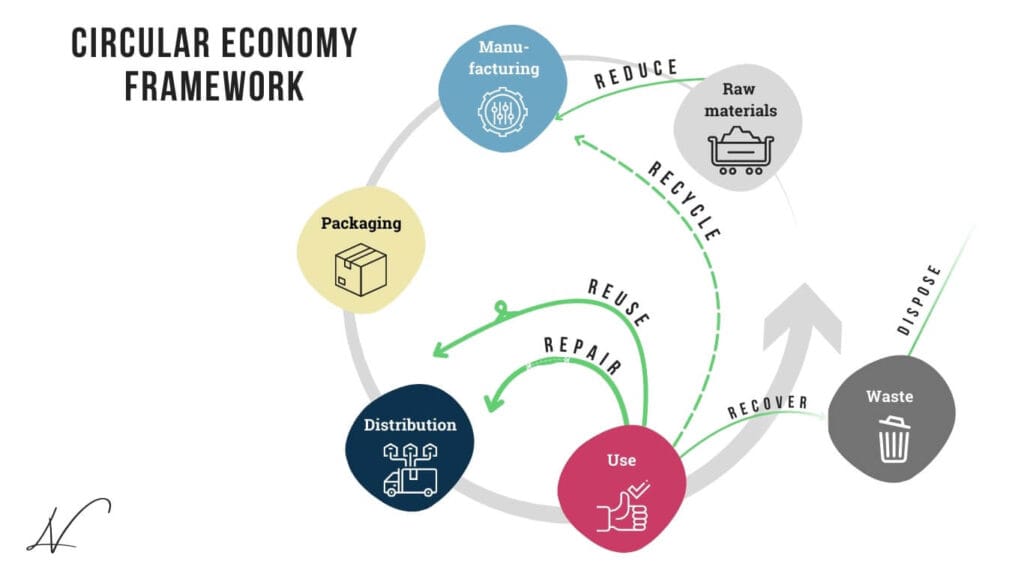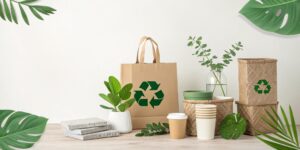About this article
This article is written in collaboration with Lolita Vérité, a consultant specializing in supply chain process optimization.
The product life cycle, between costs and environmental impact
Let’s start by stating the obvious: there’s no such thing as a perfect product with no environmental impact. Throughout its life cycle, a product will have impacts. These impacts are manifold and may involve the consumption of natural resources, the release of pollutants, greenhouse gas emissions, and so on. Good control of the material flows associated with its products is therefore essential for companies wishing to offer their customers environmentally-friendly products. Every stage in a product’s life cycle contributes to its environmental impact. This includes raw material extraction, manufacturing, transportation, use, and disposal. Some of these impacts are often perceived as inevitable and are not always questioned. And over time, we tend to lose sight of the consequences of design and production choices made out of habit, without considering their potential impact on the environment.
1-Understanding life-cycle impacts to make your product eco-friendly
Every aspect of a product’s lifecycle, including the energy and materials consumed at each stage, can have considerable repercussions. In some sectors, the materials and processes used to produce a good can account for up to a third of a company’s GHG emissions. Reducing a product’s environmental impact therefore requires an in-depth analysis of each material flow involved. From the choice of raw materials to ways of extending product life and facilitating recycling.
The environmental impact of products is not limited to production. Aspects linked to their transport, use, and end-of-life are also decisive factors in a company’s carbon footprint. Likewise, costs often exceed the mere expense of purchasing materials. An ADEME study shows that around 90% of the cost of material flows is attributable to operations on the product during its life cycle1. Striking a balance between sustainability requirements and expected product performance is a constant challenge.
For example, we need to :
- guarantee product quality while minimizing the use of non-renewable resources,
- identify materials that can be easily recycled or reused,
- consider sales areas to adapt material choices.
While not all these aspects can be addressed simultaneously, this article explores the challenges of sustainable design. It proposes methods for optimizing each stage of the product lifecycle to make it more environmentally friendly. The use of diagnostic tools, such as material flow cost analysis, is essential to fully understand the environmental impact of a product.
2-Diagnostic tools for developing a green product
2.1 Material flow cost analysis: let’s start by taking all costs into account.
As mentioned above, it’s often difficult to take into account all the costs incurred by a material flow for the company and society as a whole. If the initial invoice linked to the purchase of the product or packaging is fairly explicit, how much of the waste management company’s invoice is attributable to this material? How much time did our teams spend handling these products? What was our loss rate over the whole process?
To better understand your company’s situation, and the impact of packaging on costs, a material flow cost analysis (MFCA) will prove invaluable. This method quantifies all the costs associated with one or more raw materials, going beyond just the cost of purchasing the raw material. It aims to identify the hidden costs associated with packaging, which are essential for designing environmentally friendly, profitable products.
An analysis of this type quantifies all the costs associated with this material flow, namely :
- transport costs,
- handling (resources, vehicles),
- storage,
- internal and external waste management.
The results of this analysis provide a cost per tonne of material, which is then used to quantify the benefits of efforts to reduce material flows and produce more environmentally friendly items.
3. Key concepts for greener products: The 5R’S sequence
The 5R principle (Reduce, Reuse, Recycle, Recover, Rethink) is a hierarchical approach to waste management. It aims to minimize the impact of waste on the environment. By applying these principles to your material flows, you can reduce your costs, lessen your impact, and make your products more environmentally friendly.
Strategy 1: Reduce the material flows associated with your products
Reducing means limiting waste production by optimizing the flow of materials. This involves working on product design and the use of associated resources. This is the strategy to prioritize.
For example, we can use eco-design methods to minimize the quantity of material required, choose smaller packaging, or opt for bulk purchasing of certain sub-components.
One of our partners Lolita Vérité’s successes in this field was a project carried out with a company wishing to optimize the packaging of a new product. The main objective was to reduce the weight of the packaging and make it more environmentally friendly. The initial product was packaged in a cardboard box, with printed instructions and small non-recyclable plastic and metal clips to hold the cables.
“Right from the design phase, we worked with the supplier to find alternative, more environmentally-friendly solutions. First, we requested the use of FSC cardboard, sourced from sustainably managed forests. Next, we developed a cardboard package that served both as a product holder and a printed leaflet, eliminating the need for plastic fasteners.
Before validating this new packaging, we consulted the sales and production teams to ensure that the change would not inconvenience either customers or manufacturing processes. In the end, the solution was a resounding success, both ecologically and economically. The project has eliminated 16 km of plastic fasteners per year, considerably reducing the amount of waste produced”.
Strategy 2: Reuse
Reuse encourages the prolonged use of products and materials, giving them a second life without major transformation. Return systems can be put in place to recover products at the end of their useful life, or washing systems can be set up to enable the product to be used a second time. One example of this strategy is to reuse packaging, ideally several times. This is particularly relevant between you and your suppliers or regular customers. This strategy enables you to transform a consumable into an asset. You stop throwing the packaging away and have to buy it again each time you deliver. Instead, you always use the same equipment. A balance needs to be struck between the impact of increased weight and the need to ensure that the container is strong enough to be reused. In some cases, the use of collapsible or stackable containers can save valuable space on the return journey.
For example, a company producing electronic circuit boards has set up a shuttle-packaging system between itself and its suppliers, as an alternative to delivery in individual bags. Shuttle packaging is packaging that will be reused several times for the same product and between the same companies. In this case, the shuttle packaging is a cardboard box with dividers, also made of cardboard, to accommodate the 75 electronic cards. These cardboard boxes have foam reinforcements under the lids. All these elements (box, divider, foam, and lid) of the shuttle packaging are returned to the company by the customer once the electronic boards have been unloaded. This change has enabled us to :
- reduced annual packaging emissions by almost 90%2
- reduced packaging costs;
- facilitate handling during delivery, both to the company and to the customer, thanks to in-depth consideration of packaging ergonomics.
Strategy 3: Facilitate the repair of your products
Facilitating the repair of products to improve their environmental impact starts at the design stage. Dutch phone manufacturer Fairphone is a good example. Their smartphones are specially designed to be dismantled and repaired by users themselves. Every key component, from the battery to the screen, can be replaced without specialized tools, significantly extending the product’s lifespan. This approach not only reduces electronic waste but also limits the extraction of natural resources since replacing a component becomes a realistic alternative to buying a new device. By thinking about repairability right from the design stage, Fairphone encourages its users to care for their phones rather than replace them, illustrating a sustainable path for the technology industry and reinforcing the idea of an environmentally friendly circular economy.
Strategy 4: Use recycled materials
By using recycled and recyclable materials, you can further reduce the environmental impact of your product. Recycling involves collecting, processing,g and reusing used materials. It gives them a new life as raw materials. This reduces the consumption of natural resources, cuts waste production, and reduces the environmental impact of manufacturing and managing end-of-life products. Recycling can be applied to materials such as paper, plastic, glass, metal, and electronic waste. Diverting materials from end-of-life landfills not only avoids the emissions associated with the anaerobic decomposition of the product but also reduces the amount of raw material required by the next product.
Finally, as a last resort, consider 4-Valorize your product and exploit the residues in the material stream to obtain energy or secondary materials, notably through energy or organic recovery. Eliminate, which refers to the management of ultimate, non-reusable, or non-recyclable waste by methods such as landfill or controlled incineration, while minimizing its environmental impact.

Conclusion: Make your product eco-friendly with concrete examplese examples
In conclusion, optimizing packaging is a strategic priority for companies, both economically and environmentally. We have seen the importance of reducing the carbon footprint of packaging through key concepts such as the 3RVE (Reduce, Reuse, Recycle, Recover, Dispose), and practical tools such as material flow cost analysis (MFCA) to identify hidden costs. These concrete actions not only help reduce waste but also meet regulatory requirements and improve overall performance.
It’s time for your company to take the plunge: get your packaging assessed today, and consider an in-depth material flow analysis. This will enable you to reduce costs, strengthen your environmental commitment, and adopt sustainable practices that will benefit your customers, your image, and the planet in the long term.

This article is written in collaboration with Lolita Vérité, a consultant specializing in supply chain process optimization. With expertise in organizing and streamlining procurement and inventory processes, she helps businesses enhance their operational efficiency. Her skills empower organizations to maximize resources and optimize performance.
References
- ADEME. (2014). Full Cost of Waste. Angers. ↩︎
- ADEME, QuantiGES – Implementing Your Transition Plan, Example of Action : Mise en place d’emballage navette ↩︎
If you’d like to get started in ecology, you can contact Sustainscale’s consultants or schedule a free consultation.

